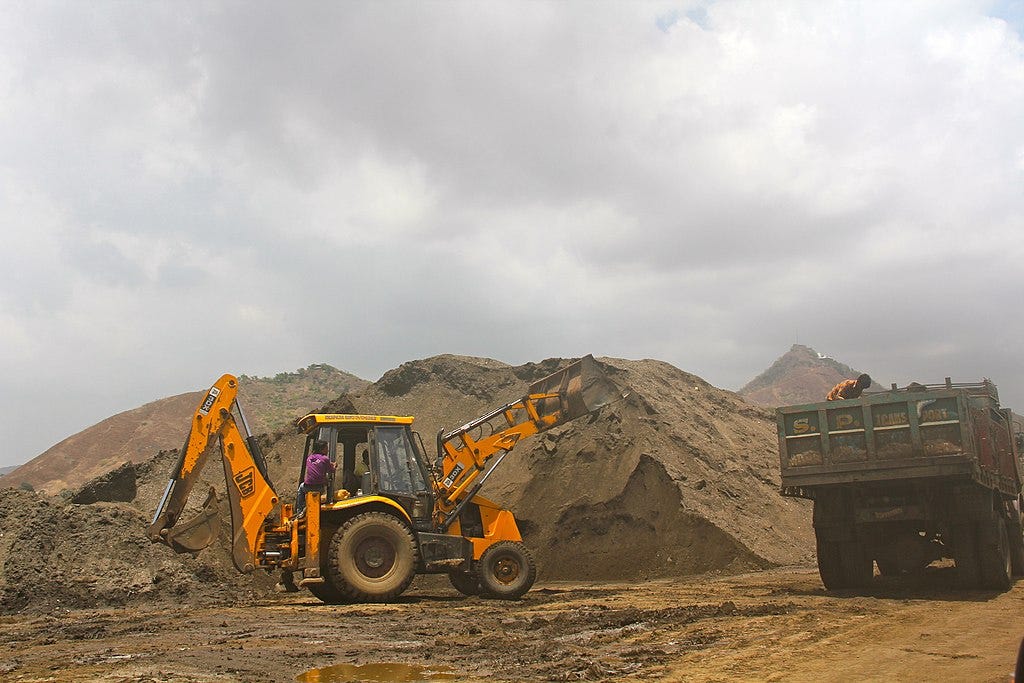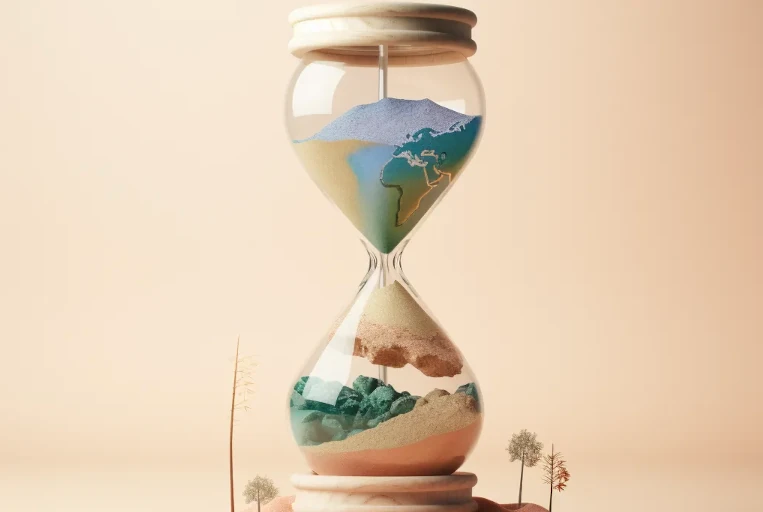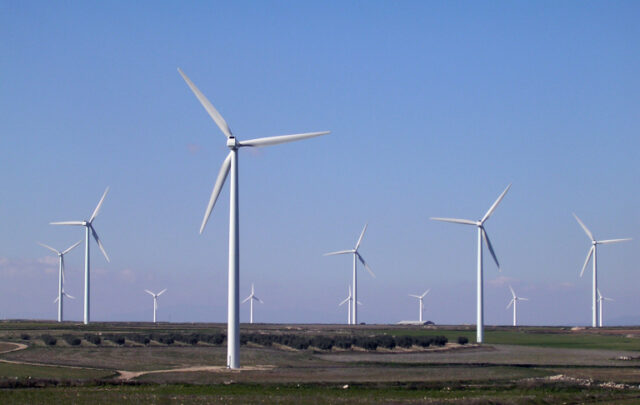Digging into sand reveals how current development paradigms work in service to capital — and at the expense of people’s wellbeing. An interview with Post Growth Fellow, Arpita Bisht
Arpita is a political ecologist specializing in conflicts related to natural resources, especially minerals. After initially focusing on bulk metals like iron ore and copper, she discovered that sand was the most conflict-prone material in India, leading her to further investigate its global significance. Arpita is an expert on sand mining, examining power dynamics in material consumption, distribution, and their societal and geopolitical impacts.
Her article, “Sand futures: Post-growth alternatives for mineral aggregate consumption and distribution in the global south,” outlines how sand extraction throughout the 21st century has led to ecological damage and violent operations, and draws connections between sand extraction and economic growth and development. We sat down with Arpita to explore why addressing the sand crisis requires systemic changes, including moving away from growth-focused models.
Post Growth Institute: Let’s start with some basics. What is sand used for, predominantly?
Arpita Bisht: Sand is a key ingredient of concrete, and the construction industry is the largest consumer of it, with two primary large-scale applications: urbanization and transport infrastructure. A notable shift has occurred in the last two decades with the emergence of island construction, which has linkages with geopolitical interests and security considerations. Another contributor is the global trend toward taller buildings and densely populated urban hubs, particularly in the Global South. Sand is also used in fracking; as a source for white pigments used in the creation of things like paint, paper, and ceramics; in glass production (glass for buildings and also eyeglasses); and in electrical devices. It’s a really pervasive material.
PGI: In your article you note that, “in all world regions, except North America and Europe, growth of non-metallic mineral consumption has been closely related to GDP growth”. Why is so much sand extracted and consumed in the Global South, and how is this linked to development paradigms?
AB: In the Global North (particularly North America and Europe), infrastructure growth largely stabilized around the late 1970s — after major redevelopments in the post WWII era. Since then, the major global construction and infrastructure development activities have shifted to the Global South. This time period of massive construction material use growth is also the era that corresponds with the Washington Consensus, which brought about, through different mechanisms, neoliberal economic growth all across the Global South. In these last decades, there has been a strong connection between surging demand for sand in the Global South and economic growth, particularly GDP growth. When we talk about development, some of the main things we refer to are urbanization and transport — elements that are deeply intertwined with capitalism and globalization. Transport infrastructure, for example, is necessary to facilitate the flow of goods and resources through national and global economies. In countries like Brazil, we see the development of roads to access parts of the Amazon for resource extraction and trade.

<
Sand mining near Mumbia (top) and in Kerala (bottom), India. Images by Sumaira Abdulali (top) and Arayilpdas (bottom), (CC-BY-3.0)
At the same time, the utilization of sand does feature in a more genuine and positive development paradigm, addressing the basic needs of populations, providing appropriate housing and improving access to transportation. However, the result of these development strategies in many Global South cities is hyper-urbanization, leading to mass migration and the transportation of sand from peri-urban areas to the city centers, creating unequal distribution within these cities. GDP growth is not a good indicator of a society’s wellbeing, but it does reflect the presence of infrastructure and urban spaces that facilitate the exchange of goods and commodities, sustaining the momentum of neoliberal growth. As a side note, I like to refer to Marx’s concept of the “spatial fix” in capitalism: some research suggests that sand resources serve as a means for capital to fix itself in space and time, particularly through extensive road infrastructures, decades or even a century into the future.
PGI: How and why does hyper-urbanization — and, by extension, sand extraction and consumption — in the Global South happen at the expense of people’s wellbeing, and in service to global capital?
AB: The problem is the coming together of global capital and local elites. Urban centers have historically served as means of commodity and capital exchange, as well as wealth accumulation, and in the post-neoliberalism era this function of urban centers is amplified across cities in the global South. Since urbanization is directly dependent on sand use, the growth of these two go hand in hand. So materially, we see the linkages between hyper-urbanization, capital accumulation, inequitable resource use, and decreasing wellbeing of large numbers of people in megacities across the Global South. In these regions, a small, elite group, often comprising just one percent of the population, exploits the rhetoric of development and progress to amass considerable wealth. This phenomenon is strikingly evident in cities like Mumbai, where a concentration of billionaires and multimillionaires coexists with sprawling ‘slums’.

Mumbai, India. Photo by Alfarnas Solkar on Unsplash
Such wealth disparities give rise to a dynamic of exploitation, facilitating easy access to cheap labor within enclaves of extreme affluence. Urbanization deprives rural areas and leads to an influx of migrants to cities, generating an ample pool of exploitable labor: a boon for GDP. In megacities with populations of 25 to 30 million people, between 80 and 95 percent work in informal industries. It’s beneficial for global capital to have this reserve of cheap, exploitable labor. Further, due to its weight, sand is not transported long distances — unlike iron ore, copper, coal, or oil, for example — so the local element has a stronger role to play. These are patterns which are observed to be recurring in differing degrees, but prevalent across cities in the Global South.
PGI: What does ‘post growth’ mean to you in this context?
AB: ‘Post-growth’ encompasses four distinct schools of thought, each offering a unique perspective. The first is the concept of a steady-state economy, as envisioned by Herman Daly. This isn’t the same as the neoliberal steady state; it is about first achieving a minimum amount of material access for all, and after that maintaining a constant stock of materials in flow in a society. Further, it’s about creating a society that maintains a stable equilibrium, avoiding excessive deprivation, and embracing a more sustainable way of living. Another viewpoint is ‘agrowth,’ where the idea is to become growth-agnostic, which questions whether growth is inherently problematic–for instance, if GDP growth is truly leading to increased decent housing, energy and food access to the deprived sections of society, then that growth is not a problem. Next, ‘post-development’ challenges the foundations of neoliberalism, development economics, and the imposition of dominant growth models by institutions like the Chicago School — there’s a wealth of literature, beginning around the 1960s and 70s, that delves into alternative perspectives. Finally, there’s ‘degrowth,’ which forms an essential part of this discourse on growth. The difference lies in how we perceive growth; in the Global South, the conversation isn’t always about GDP itself. There are moments, such as in housing and basic infrastructure, where growth is essential to meet the needs of marginalized sections of the population. This stands in contrast to the need of the Global North–which must focus on reduction in over-consumption of resources, and maintenance of existing stock of built infrastructures.
PGI: How can we link some of these post-growth approaches to the particular issue of sand extraction?
AB: One example of a post-growth approach is the concept of resource capping — this falls under the umbrella of ‘post-extractivism’, which involves careful planning and control over the use and distribution of resources. For instance, in the case of resources like iron or aluminum, there have been proposals to limit their production and distribution, with a focus on not selling to certain industries, such as the arms industry. In the case of sand, this could involve, for instance not using any further resources for luxury consumptions — extra houses for owners of multiple homes and luxury real estate, and rather using these resources for decent housing for all.
Similarly, a policy focused on people-centric transport and not trade or car-based infrastructures. When it comes to resources like sand, the decision-making process is very localized, involving nation-states, local councils, districts, and provinces. It’s crucial to examine the scale of infrastructure needed and how cities are planned. Comparing the structure of European cities, which often favor eco-friendly transportation like biking, to those in the Global South reveals disparities. The question arises as to why models that promote sustainable living aren’t more widely adopted in the South. The challenge here is that such models are not conducive to growth. A healthier society where cities work for all may not provide access to cheap labor, which poses a significant issue in a growth-focused paradigm! We need to shift towards more sustainable and equitable planning that considers a higher quality of life, even if it means reevaluating traditional notions of growth.
PGI: What is the role of existing Indigenous or traditional architectural knowledge in exploring alternatives to concrete?
AB: It’s about tapping into the wealth of knowledge that already exists, both conceptually and practically, in order to reduce the use of concrete and prioritize ecologically sound and locally appropriate materials. Local governments, if properly empowered, can allocate funds to support the maintenance and management of housing structures made using traditional or vernacular techniques. In rural areas, for example, government funding can be harnessed for the upkeep of local communities. When used wisely, this funding fosters thriving local cultures, retains local aesthetics, and encourages the use of long-lasting materials like fire- and termite-resistant woods. (While this approach proves effective in many instances, the unfortunate reality is that it’s not as widespread as it should be due to issues like corruption.)
PGI: How can these local successes be translated to policy?
AB: This is not easy as it involves challenging the growth narrative. There needs to be an alliance or some kind of discourse between post-growth economics, architects, and urban planners. Buildings can be made of so many different materials and adapted to local climatic conditions, and with architects and urban planners on board, we could have small-scale city-based solutions in the Global South. Another interesting point is that in Europe, such architecture is called ‘heritage’; whereas in the Global South it’s known as ‘vernacular’ architecture — implying it’s non-technical, traditional, and basically the opposite of modern. The language we use is important. What’s more, built infrastructure really affects people’s lives in unexpected ways, on an individual and societal level. When we create environments that cater to high-speed, high-consumption lifestyles it has notable effects on mental health and social inclusion (or lack of it).
It’s also important to note that not all ‘traditional’ approaches are necessarily better, just as modern ones are not all harmful. For example, in India, many traditional houses lack toilets, which poses significant sanitation challenges, especially for women. While preserving these structures is important, there’s a need to integrate modern sanitation facilities within households. Similarly, addressing indoor pollution in kitchens can involve mixing traditional practices with contemporary improvements. The idea is to adopt and adapt, combining Indigenous knowledge with modern solutions. The key is not to remain confined to one extreme or the other but to find a balance that best serves people’s wellbeing and that of wider society and the environment.
Inspired? Here are some things you can do next:
- Read The World in a Grain: The Story of Sand and How It Transformed Civilization by Vince Beiser — as well as these articles, written or co-authored by Arpita:
- Bisht, A., 2021. Conceptualizing sand extractivism: Deconstructing an emerging resource frontier. The Extractive Industries and Society, 8(2), p.100904.
- Bisht, A., 2019. Discontent, conflict, social resistance and violence at non-metallic mining frontiers in India. Ecology, Economy and Society-the INSEE Journal, 2(2354–2020–1300), pp.31–42.
- Bisht, A. and Martinez‐Alier, J., 2023. Coastal sand mining of heavy mineral sands: Contestations, resistance, and ecological distribution conflicts at HMS extraction frontiers across the world. Journal of Industrial Ecology, 27(1), pp.238–253.
2. Donate to Awaaz Foundation, India Sand Watch, or Land Conflict Watch.
3. Support or get involved with the work of The Global Atlas of Environmental Justice (EJATLAS), The South Asia Network on Dams, Rivers and People, and Land Conflict Watch.





